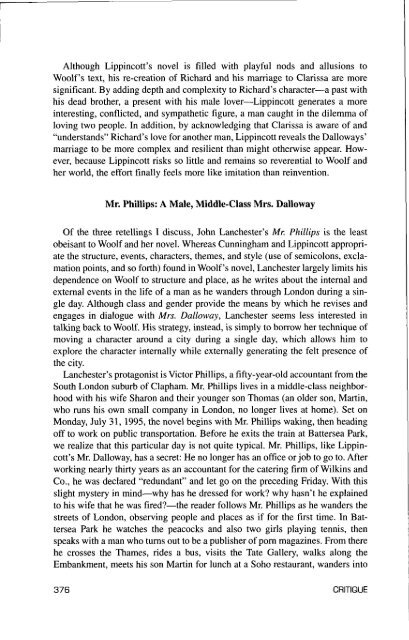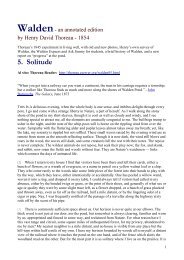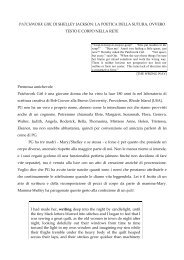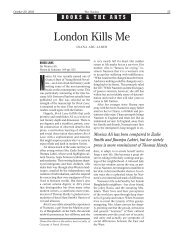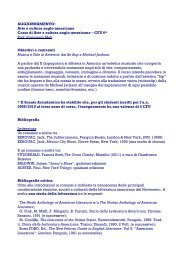Rewriting Woolf s Mrs. Dalloway: Homage, Sexual ... - Paola Carbone
Rewriting Woolf s Mrs. Dalloway: Homage, Sexual ... - Paola Carbone
Rewriting Woolf s Mrs. Dalloway: Homage, Sexual ... - Paola Carbone
Create successful ePaper yourself
Turn your PDF publications into a flip-book with our unique Google optimized e-Paper software.
Although Lippincott's novel is filled with playful nods and allusions to<strong>Woolf</strong> s text, his re-creation of Richard and his marriage to Clarissa are moresignificant. By adding depth and complexity to Richard's character—a past withhis dead brother, a present with his male lover—Lippincott generates a moreinteresting, confiicted, and sympathefic figure, a man caught in the dilemma ofloving two people. In addition, by acknowledging that Clarissa is aware of and"understands" Richard's love for another man, Lippincott reveals the <strong>Dalloway</strong>s'marriage to be more complex and resilient than might otherwise appear. However,because Lippincott risks so little and remains so reverential to <strong>Woolf</strong> andher world, the effort finally feels more like imitation than reinvention.Mr. Phillips: A Male, Middle-Class <strong>Mrs</strong>. <strong>Dalloway</strong>Of the three retellings I discuss, John Lanchester's Mr. Phillips is the leastobeisant to <strong>Woolf</strong> and her novel. Whereas Cunningham and Lippincott appropriatethe structure, events, characters, themes, and style (use of semicolons, exclamationpoints, and so forth) found in <strong>Woolf</strong>'s novel, Lanchester largely limits hisdependence on <strong>Woolf</strong> to structure and place, as he writes about the internal andexternal events in the life of a man as he wanders through London during a singleday. Although class and gender provide the means by which he revises andengages in dialogue with <strong>Mrs</strong>. <strong>Dalloway</strong>, Lanchester seems less interested intalking back to <strong>Woolf</strong>. His strategy, instead, is simply to borrow her technique ofmoving a character around a city during a single day, which allows him toexplore the character internally while externally generating the felt presence ofthe city.Lanchester's protagonist is Victor Phillips, a fifty-year-old accountant from theSouth London suburb of Clapham. Mr. Phillips lives in a middle-class neighborhoodwith his wife Sharon and their younger son Thomas (an older son, Martin,who runs his own small company in London, no longer lives at home). Set onMonday, July 31, 1995, the novel begins with Mr. Phillips waking, then headingoff to work on public transportation. Before he exits the train at Battersea Park,we realize that this particular day is not quite typical. Mr. Phillips, like Lippincott'sMr. <strong>Dalloway</strong>, has a secret: He no longer has an office or job to go to. Afterworking nearly thirty years as an accountant for the catering firm of Wilkins andCo., he was declared "redundant" and let go on the preceding Friday. With thisslight mystery in mind—why has he dressed for work? why hasn't he explainedto his wife that he was fired?—the reader follows Mr. Phillips as he wanders thestreets of London, observing people and places as if for the first time. In BatterseaPark he watches the peacocks and also two girls playing tennis, thenspeaks with a man who turns out to be a publisher of pom magazines. From therehe crosses the Thames, rides a bus, visits the Tate Gallery, walks along theEmbankment, meets his son Martin for lunch at a Soho restaurant, wanders into376 CRITIQUE


